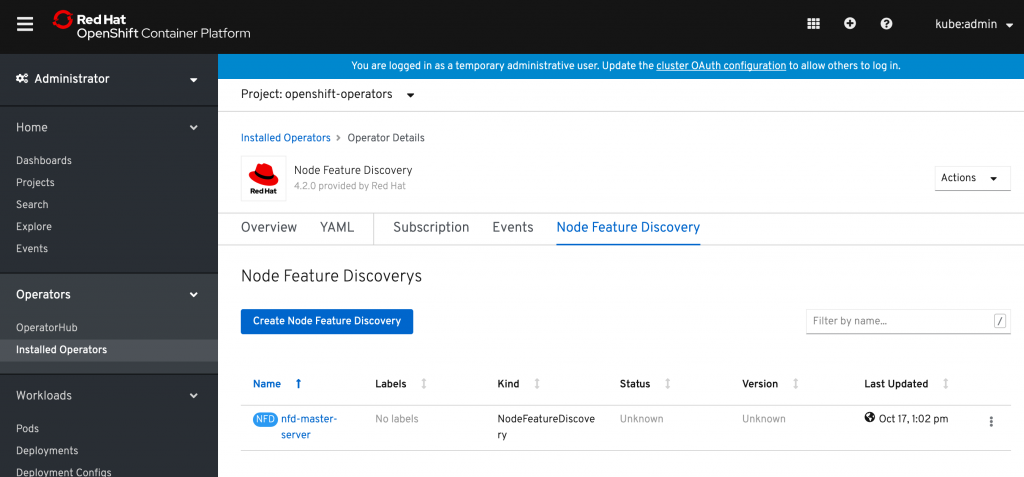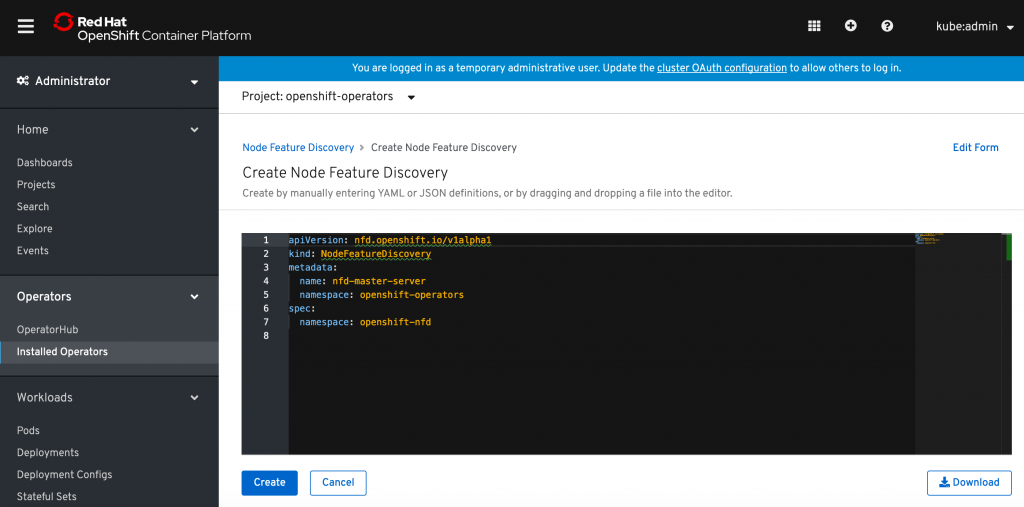Red Hat blog
OpenShift Container Platform 4 uses the Machine API operator to fully automate infrastructure provisioning. The Machine API provides full stack infrastructure automation on public or private clouds.
With the release of OpenShift Container Platform 4.2, administrators can easily define GPU-enabled nodes in EC2 using the Machine API and the Node Feature Discovery operator.
These instructions assume that you have OpenShift Container Platform 4 installed in AWS using the Installer Provided Infrastructure (IPI) installation method.
Machines and Machine Sets
The Machine API operator defines several custom resources to manage nodes as OpenShift objects. These include Machines and MachineSets.
- A Machine defines instances with a desired configuration in a given cloud provider.
- A MachineSet ensures that the specified number of machines exist on the provider. A MachineSet can scale machines up and down, providing self-healing functionality for the infrastructure.
The Machine/MachineSet abstraction allows OpenShift Container Platform to manage nodes the same way it manages pods in replica sets. They can be created, deleted, updated, scaled, and destroyed from the same object definition.
In this blog post we copy and modify a default worker MachineSet configuration to create a GPU-enabled MachineSet (and Machines) for the AWS EC2 cloud provider.
NOTE: This blog post shows how to deploy a GPU-enabled node running Red Hat Enterprise Linux CoreOS. With OpenShift Container Platform 4.2, GPUs are supported in Red Hat Enterprise Linux (RHEL) 7 nodes only. This process is not supported. Please see the release notes for details.
Add a GPU Node
First view the existing nodes, Machines, and MachineSets.
Each node is an instance of a machine definition with a specific AWS region and OpenShift role.
$ oc get nodes
NAME STATUS ROLES AGE VERSION
ip-10-0-131-156.us-east-2.compute.internal Ready master 21m v1.14.6+c07e432da
ip-10-0-132-241.us-east-2.compute.internal Ready worker 16m v1.14.6+c07e432da
ip-10-0-144-128.us-east-2.compute.internal Ready master 21m v1.14.6+c07e432da
ip-10-0-151-24.us-east-2.compute.internal Ready worker 15m v1.14.6+c07e432da
ip-10-0-166-12.us-east-2.compute.internal Ready worker 16m v1.14.6+c07e432da
ip-10-0-173-34.us-east-2.compute.internal Ready master 21m v1.14.6+c07e432da
The Machines and MachineSets exist in the openshift-machine-api namespace. Each worker machine set is associated with a different availability zone within the AWS region. The installer automatically load balances workers across availability zones.
$ oc get machinesets -n openshift-machine-api
NAME DESIRED CURRENT READY AVAILABLE AGE
openshift-blog-txxtf-worker-us-east-2a 1 1 1 1 22m
openshift-blog-txxtf-worker-us-east-2b 1 1 1 1 22m
openshift-blog-txxtf-worker-us-east-2c 1 1 1 1 22m
Right now there is only one worker machine per machine set, though a machine set could be scaled to add a node in a particular region and zone.
$ oc get machines -n openshift-machine-api | grep worker
openshift-blog-txxtf-worker-us-east-2a-8grnb running m4.large us-east-2 us-east-2a 51m
openshift-blog-txxtf-worker-us-east-2b-vw4ph running m4.large us-east-2 us-east-2b 51m
openshift-blog-txxtf-worker-us-east-2c-qpd4q running m4.large us-east-2 us-east-2c 51m
Make a copy of one of the existing worker MachineSet definitions and output the result to a JSON file. This will be the basis for our GPU-enabled worker machine set definition.
$ oc get machineset openshift-blog-txxtf-worker-us-east-2a -n openshift-machine-api -o json > openshift-blog-txxtf-gpu-us-east-2a.json
Notice that we are replacing “worker” with “gpu” in the file name. This will be the name of our new MachineSet.
Edit the JSON file. Make the following changes to the new MachineSet definition:
Change the instance type of the new MachineSet definition to p3, which includes an NVIDIA Tesla V100 GPU. Read more about AWS P3 instance types: https://aws.amazon.com/ec2/instance-types/#Accelerated_Computing
$ jq .spec.template.spec.providerSpec.value.instanceType openshift-blog-txxtf-gpu-us-east-2a.json
"p3.2xlarge"
Change the name and self link to a unique name that identifies the new MachineSet. Then delete the status section from the definition.
A diff of the original worker definition and the new GPU-enabled node definition looks like this:
$ oc -n openshift-machine-api get machineset openshift-blog-txxtf-worker-us-east-2a -o json | diff openshift-blog-txxtf-gpu-us-east-2a.json -
10c10
< "name": "openshift-blog-txxtf-gpu-us-east-2a", --- > "name": "openshift-blog-txxtf-worker-us-east-2a",
13c13
< "selfLink": "/apis/machine.openshift.io/v1beta1/namespaces/openshift-machine-api/machinesets/openshift-blog-txxtf-gpu-us-east-2a", --- > "selfLink": "/apis/machine.openshift.io/v1beta1/namespaces/openshift-machine-api/machinesets/openshift-blog-txxtf-worker-us-east-2a",
21c21
< "machine.openshift.io/cluster-api-machineset": "openshift-blog-txxtf-gpu-us-east-2a" --- > "machine.openshift.io/cluster-api-machineset": "openshift-blog-txxtf-worker-us-east-2a"
31c31
< "machine.openshift.io/cluster-api-machineset": "openshift-blog-txxtf-gpu-us-east-2a" --- > "machine.openshift.io/cluster-api-machineset": "openshift-blog-txxtf-worker-us-east-2a"
60c60
< "instanceType": "p3.2xlarge", --- > "instanceType": "m4.large",
104a105,111
> },
> "status": {
> "availableReplicas": 1,
> "fullyLabeledReplicas": 1,
> "observedGeneration": 1,
> "readyReplicas": 1,
> "replicas": 1
Create the new MachineSet from the definition.
$ oc create -f openshift-blog-txxtf-gpu-us-east-2a.json
machineset.machine.openshift.io/openshift-blog-txxtf-gpu-us-east-2a created
View the new MachineSet.
$ oc -n openshift-machine-api get machinesets | grep gpu
openshift-blog-txxtf-gpu-us-east-2a 1 1 1 1 4m21s
The MachineSet replica count is set to “1” so a new Machine object is created automatically. View the new Machine object.
$ oc -n openshift-machine-api get machines | grep gpu
openshift-blog-txxtf-gpu-us-east-2a-rd665 running p3.2xlarge us-east-2 us-east-2a 4m36s
Eventually a node will come up based on the new definition. Find the node name.
$ oc -n openshift-machine-api get machines | grep gpu
openshift-blog-txxtf-gpu-us-east-2a-rd665 running p3.2xlarge us-east-2 us-east-2a 5m8s
View the metadata associated with the new node, including its labels. You can see the instance-type, operating system, zone, region, and hostname.
$ oc get node ip-10-0-132-138.us-east-2.compute.internal -o json | jq .metadata.labels
{
"beta.kubernetes.io/arch": "amd64",
"beta.kubernetes.io/instance-type": "p3.2xlarge",
"beta.kubernetes.io/os": "linux",
"failure-domain.beta.kubernetes.io/region": "us-east-2",
"failure-domain.beta.kubernetes.io/zone": "us-east-2a",
"kubernetes.io/arch": "amd64",
"kubernetes.io/hostname": "ip-10-0-132-138",
"kubernetes.io/os": "linux",
"node-role.kubernetes.io/worker": "",
"node.openshift.io/os_id": "rhcos"
}
Note that there is no need to specify a namespace for the node. The node definition is cluster scoped.
Deploy the Node Feature Discovery Operator
After the GPU-enabled node is created, it’s time to discover the GPU enabled node so it can be scheduled. The first step in this process is to install the Node Feature Discovery (NFD) operator.
The NFD operator identifies hardware device features in nodes. It solves the general problem of identifying and cataloging hardware resources in the infrastructure nodes so they can be made available to OpenShift.
Install the Node Feature Discovery operator from OperatorHub in the OpenShift Container Platform console.
Once the NFD operator is installed into OperatorHub, select Node Feature Discovery from the installed operators list and select Create instance. This will install the openshift-nfd operator into the openshift-operators namespace.
Verify the operator is installed and running.
$ oc get pods -n openshift-operators
NAME READY STATUS RESTARTS AGE
nfd-operator-fd55688bd-4rrkq 1/1 Running 0 18m
Next, browse to the installed operator in the console. Select Create Node Feature Discovery.
Select Create to build a NFD Custom Resource. This will create NFD pods in the openshift-nfd namespace that poll the OpenShift nodes for hardware resources and catalogue them.
After a successful build, verify that a NFD pod is running on each nodes.
$ oc get pods -n openshift-nfd
NAME READY STATUS RESTARTS AGE
nfd-master-mc99f 1/1 Running 0 51s
nfd-master-t7rrl 1/1 Running 0 51s
nfd-master-w9pgx 1/1 Running 0 51s
nfd-worker-5wwnw 1/1 Running 2 51s
nfd-worker-h2p2p 1/1 Running 2 51s
nfd-worker-n99l2 1/1 Running 2 51s
nfd-worker-xmmqx 1/1 Running 2 51s
The NFD operator uses vendor PCI IDs to identify hardware in a node. NVIDIA uses the PCI ID 10de. View the NVIDIA GPU discovered by the NFD operator.
$ oc describe node ip-10-0-132-138.us-east-2.compute.internal | egrep 'Roles|pci'
Roles: worker
feature.node.kubernetes.io/pci-1013.present=true
feature.node.kubernetes.io/pci-10de.present=true
feature.node.kubernetes.io/pci-1d0f.present=true
10DE appears in the node feature list for the GPU-enabled node we defined. So the NFD operator correctly identified the node from our GPU-enabled MachineSet.
Conclusion
And that’s it! The Machine API lets us define, template, and scale nodes as easily as pods in ReplicaSets. We used the worker MachineSet definition as a template to create a GPU-enabled MachineSet definition with a different AWS instanceType. After we built a new node from this definition, we installed the Node Feature Discovery operator from OperatorHub. It detected the GPU and labeled the node so the GPU can be exposed to OpenShift’s scheduler. Taken together this is a great example of the power and simplicity of full stack automation in OpenShift Container Platform 4.2.
Subsequent blog posts will describe the process for loading GPU drivers and running jobs. The approaches differ slightly depending on whether the GPU drivers and libraries are installed directly to the host or dep;oyed via a pod daemon set.
Resources
About the author
Red Hatter since 2018, tech historian, founder of themade.org, serial non-profiteer.





